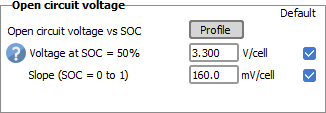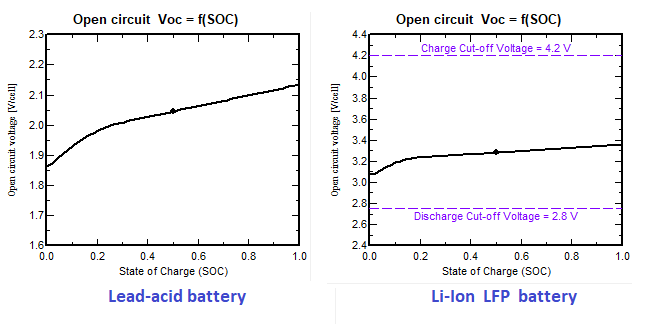|
<< Click to Display Table of Contents >> Open Circuit Voltage |
  
|
|
<< Click to Display Table of Contents >> Open Circuit Voltage |
  
|
(see also "Lead-acid voltage model" and "Lithium-ion OCV model")
The Voc behavior is the basic function for the modelling of the full battery voltage:
- when charging or discharging, we have to add (or substract) the voltage drop proportional to the current, according to the internal resistance (dV = Ri * I)
- in lead-acid batteries, in full charge conditions (above SOC around 80%) there will be an additional voltage due to the Gassing phenomenon.
A satisfactory voltage modelling is very important when using a controlling device operating according to voltage thresholds.
Lead-acid batteries:
The Voc is supposed linear as a function of the SOC (State of Charge). The mid point (SOC = 50%) is set to 2.045 V (at 20°C) , and the slope is 178.2 mV for the full SOC range.
A correcting (quadratic) function is applied below SOC = 20%.
The voltage is dependent on the temperature, with a linear temperature coefficient (sometimes specified by the manufacturer) of -4 to -5 mV/°C.
These parameters are rather stable for any model, as they are mainly related to the PbSO4 chemistry properties.
Li-Ion batteries:
The Voc is also supposed to be linear. But the mid-voltage and the slope are dependent on the chemistry. As an example:
- for Li-LFP technology, the mid-voltage is usually around 3.3 V, and the slope around 0.15 V / SOC
- For NMC and NCA, the mid-voltage is around 3.7 V, and the slope is much higher, around 0.78 V / SOC
As for Lead-acid, there is also a diminishing function below SOC = 10 or 15%, which we try to evaluate from the discharge curves provided by the manufacturers.
The open circuit voltage is not supposed to be dependent on the temperature.
The model doesn't involve an increase of the open circuit voltage at high SOC: the effective voltage increase will be due to a drastic increase of the internal resistance for the charging current.


In this tool, you have the opportunity to get the exact voltage value for a specified SOC.